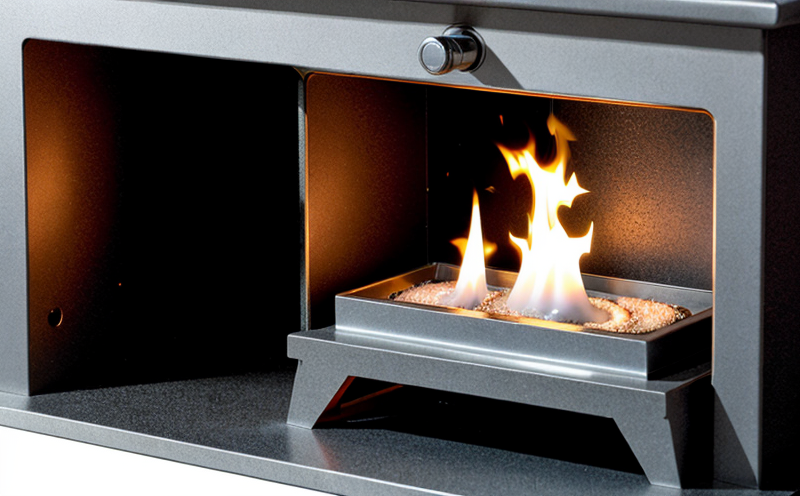Flame Spread Testing of Fire-Retardant Fabrics
The Flame Spread Testing of Fire-Retardant Fabrics is a critical procedure within fire safety testing, designed to assess the surface flame spread and ignitability properties of materials used in various industries. This test ensures that fabrics meet stringent international standards aimed at reducing the risk of fire-related accidents and injuries. The primary goal is to determine the rate at which flames travel across the material's surface and the time it takes for self-extinction, providing valuable insights into a fabric’s resistance to ignition.
The testing process involves controlled exposure to a flame source under specific conditions that simulate real-world scenarios. Specimens are placed on a standardized test stand where they are exposed to both gas flames and solid fuel-based fires. The duration of the flame contact is measured, along with the distance over which the flame spreads. This information helps in quantifying the material’s fire resistance, ensuring compliance with safety regulations.
Accurate flame spread testing requires precise control over environmental factors such as temperature, humidity, and ventilation to ensure consistent results across different test runs. The apparatus used for this purpose includes a specially designed chamber equipped with gas burners that can be adjusted for height and intensity. Additionally, solid fuel-based ignitability tests may involve the use of a propane burner or an equivalent device capable of replicating the conditions under which fabrics might encounter fire.
Once testing is complete, data analysis plays a crucial role in interpreting results. This involves measuring the time it takes for flames to spread across the material and determining whether self-extinction occurs within the prescribed limits. Compliance with standards such as ASTM E84-19 (Standard Test Method for Surface Burning Characteristics of Building Materials), ISO 6702:2013, and EN 13501-1 ensures that fabrics are appropriately classified according to their fire resistance levels.
The results from flame spread testing provide essential information for material developers, quality assurance teams, and compliance officers. By identifying areas where improvements can be made, these tests contribute significantly to enhancing product safety and reducing the likelihood of fire incidents in everyday use environments like homes, offices, and public spaces.
Industry Applications
- Furniture Manufacturing: Ensures that upholstery fabrics meet stringent flammability standards, protecting consumers from potential hazards.
- Clothing Production: Validates the fire resistance of clothing materials used in high-risk environments such as hospitals and emergency services.
- Textile Industry: Assists manufacturers in developing new fire-retardant fabrics that comply with international regulations.
- Automotive Sector: Helps automotive interior designers select materials that prevent fires from spreading rapidly within vehicles.
The outcome of flame spread testing is particularly important for industries where the risk of fire is high, ensuring that materials used in these sectors are safe and reliable. These tests not only enhance product performance but also contribute to overall safety standards across various applications.
Quality and Reliability Assurance
- Precision Instruments: Utilizes advanced instruments like the Cone Calorimeter for accurate measurement of heat release rates during combustion.
- Standardized Procedures: Adheres to internationally recognized protocols such as ASTM E84-19 and ISO 6702:2013 to ensure consistent testing results.
- Data Analysis: Comprehensive analysis of flame spread data ensures that materials meet the required fire resistance levels.
The laboratory adheres strictly to these protocols, ensuring that every test conducted is both reliable and repeatable. This commitment to quality guarantees that products tested will perform consistently under real-world conditions, thereby enhancing trust in brand reputation and consumer safety.
Competitive Advantage and Market Impact
The Flame Spread Testing of Fire-Retardant Fabrics offers numerous competitive advantages. By providing accurate data on fire resistance performance, this service helps manufacturers stay ahead of regulatory changes and market demands for safer products. Compliance with international standards is not only a legal requirement but also a significant differentiator in the global marketplace.
Moreover, successful completion of these tests can lead to increased sales opportunities as consumers become more aware of the importance of fire safety. Brands that demonstrate a commitment to quality through rigorous testing are likely to gain consumer loyalty and trust. In addition, having reliable data on flame spread properties allows companies to innovate by developing new materials and designs that push boundaries while maintaining high levels of safety.
The market for fire-resistant fabrics continues to grow as awareness around fire hazards increases globally. Companies offering comprehensive flame spread testing services play a pivotal role in driving this trend forward, ensuring that the products they supply meet or exceed industry expectations. This proactive approach not only strengthens brand reputation but also contributes positively towards societal safety goals.





